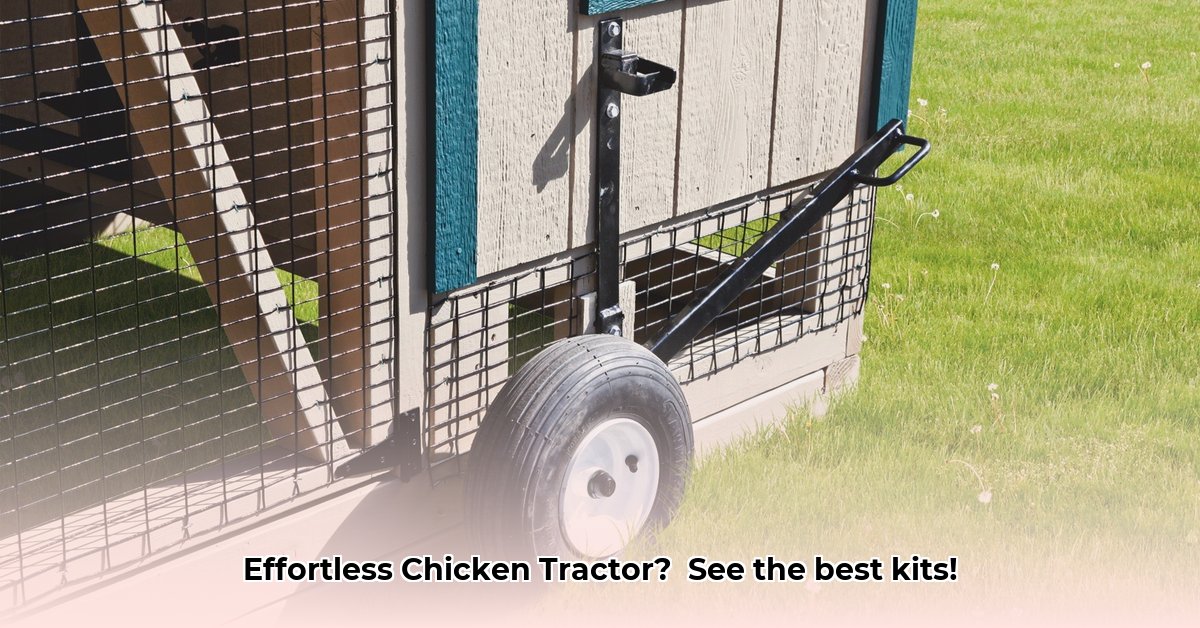
Moving a heavy chicken coop shouldn't be a Herculean task. The weight of the coop, plus feed, chickens, and nesting boxes, can quickly make relocation a major workout. Thankfully, wheel kits like EggCartnWheel and ChickLift are designed to make this process significantly easier. This comparative review will help you decide which system best suits your needs and budget. For more DIY coop ideas, check out this helpful resource.
Installation: A Step-by-Step Comparison
Both EggCartnWheel and ChickLift advertise straightforward installation, though EggCartnWheel suggests a 15-30 minute setup time, while ChickLift provides no estimated timeframe. Basic tools such as screwdrivers and possibly a socket wrench are typically sufficient for both.
EggCartnWheel Installation:
- Unpack all components and carefully review the illustrated instructions.
- Attach the wheel assemblies to your chicken tractor using bolts or screws, referring to the instructions for precise placement.
- Ensure all connections are secure and firmly tightened.
- Test the lifting mechanism for smooth operation.
ChickLift Installation:
- Review the provided instructions and any accompanying videos for visual guidance.
- Attach the lift bar and wheel assemblies to your coop, following the manufacturer's instructions carefully.
- Thoroughly inspect all connections to confirm stability.
- Test the lift mechanism to ensure proper functionality.
Weight Capacity & Dimensions: Matching the System to Your Coop
A significant difference lies in weight capacity. EggCartnWheel supports approximately 400 lbs, suitable for coops up to roughly 10' x 12'. ChickLift boasts a much higher capacity—up to 600 lbs per side, accommodating larger, heavier coops. Remember to account for the coop's weight, plus chickens, feed, etc., when making your decision.
| Feature | EggCartnWheel | ChickLift |
|---|---|---|
| Weight Capacity (approx.) | 400 lbs | 600 lbs per side |
| Maximum Coop Dimensions | Up to 10' x 12' | Significantly larger |
| Lifting Mechanism | Two-pedal system | Single lift bar |
| Tire Type | Foam-filled | Solid rubber |
Tire Durability: Foam-Filled vs. Solid Rubber
EggCartnWheel uses foam-filled tires, while ChickLift utilizes solid rubber. Both offer "flat-free" operation, a key advantage. However, long-term durability comparisons require further research. Foam tires may provide a smoother ride, but solid rubber might offer superior resistance to wear and tear. Checking user reviews that detail long-term performance is crucial before purchasing.
Ease of Use & Maneuverability: Two Pedals vs. Single Bar
EggCartnWheel's two-pedal system allows for independent lifting of each side, facilitating maneuvering around obstacles and uneven terrain, which is crucial for ease of use. ChickLift’s single lift bar, while potentially simpler in design, may require more coordination. The “easier” system depends on individual preferences. Individuals with mobility limitations might find the independent control of the EggCartnWheel more manageable.
Pricing & Warranty: Comparing Value and Protection
Direct price comparison is difficult due to fluctuating online prices and varying retailer markups. Nevertheless, examining return policies and warranty information is essential. EggCartnWheel seems to offer a more lenient return policy, while ChickLift's policy may be more restrictive. Thorough research into both companies’ warranty details is highly recommended before purchasing.
User Experience: Gathering Real-World Feedback
Before committing to a purchase, exploring user reviews is vital. These can highlight strengths and weaknesses not always apparent in marketing materials. Compare multiple reviews to gain a holistic view of each system's performance in various settings and with different coop sizes and weights.
Final Verdict & Recommendations
The ideal choice depends on your specific needs. EggCartnWheel's maneuverability and suitability for smaller coops make it a strong contender for users prioritizing ease of use and precise control on relatively flat terrain. ChickLift’s superior weight capacity makes it ideal for larger, heavier coops, even if it sacrifices some maneuverability for simpler lifting mechanics. Carefully consider your coop’s size, weight, budget, and your own physical capabilities before making a final decision.
Conclusion: Navigating Your Chicken Tractor's Mobility
Moving your chicken tractor shouldn't be a struggle. By thoughtfully comparing EggCartnWheel and ChickLift, considering their features and limitations, and researching user feedback, you can select the wheel kit that best meets your needs and ensures effortless chicken coop relocation. Remember to prioritize factors like coop weight and terrain challenges when making your selection.